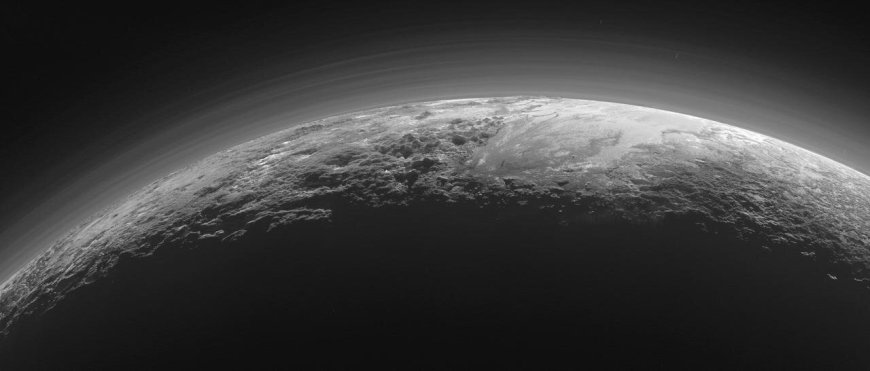New Horizons Successfully Tests Deep Space Navigation with Nearby Stars
NASA's New Horizons spacecraft, after its Pluto mission, conducted a groundbreaking experiment in deep space navigation. Using nearby stars, researchers demonstrated accurate stellar parallax measurements, paving the way for future interstellar exploration.

Just 15 minutes after its closest approach to Pluto on July 14, 2015, NASA's New Horizons spacecraft looked back toward the sun and captured this near-sunset view of the rugged, icy mountains and flat ice plains extending to Pluto's horizon. The smooth expanse of the informally named icy plain Sputnik Planum (right) is flanked to the west (left) by rugged mountains up to 11,000 feet (3,500 meters) high, including the informally named Norgay Montes in the foreground and Hillary Montes on the skyline. To the right, east of Sputnik, rougher terrain is cut by apparent glaciers. The backlighting highlights more than a dozen layers of haze in Pluto's tenuous but distended atmosphere. The image was taken from a distance of 11,000 miles (18,000 kilometers) to Pluto; the scene is 780 miles (1,250 kilometers) wide. Credit: NASA/Johns Hopkins University Applied Physics Laboratory/Southwest Research Institute
As NASA's New Horizons spacecraft traveled through the Kuiper Belt at a distance of 438 million miles from Earth, an international team of astronomers used the far-flung probe to conduct an unprecedented experiment: the first-ever successful demonstration of deep space stellar navigation.
A paper describing the results was accepted for publication in The Astronomical Journal. The pre-print is available on the server arXiv.
As a proof-of-concept test, the researchers took advantage of the spacecraft's unique vantage point as it traveled toward interstellar space to image two of our nearest stellar neighbors, Proxima Centauri, which is 4.2 light-years from Earth, and Wolf 359, which is 7.86 light-years away.
From New Horizons' perspective, the two nearby stars shifted their apparent positions in the sky as they appear to astronomers here on Earth, an effect known as stellar parallax.
Using the positions of the two stars and referencing a three-dimensional model of the solar neighborhood, the team calculated the spacecraft's position relative to nearby stars with an accuracy of about 4.1 million miles. (This is comparable to an accuracy of about 26 inches as measured from New York to Los Angeles.)
Although this demonstration did not yield research-grade results, the researchers note that directly observing large stellar parallaxes from widely separated simultaneous observers is vividly educational.
Viewed from the top of the Vehicle Assembly Building at Kennedy Space Center, NASA's New Horizons spacecraft roars off the launch pad aboard an Atlas V rocket spewing flames and smoke. Liftoff was on time at 2 p.m. EST from Complex 41 on Cape Canaveral Air Force Station in Florida. This was the third launch attempt in as many days after scrubs due to weather concerns. The compact, 1,050-pound piano-sized probe will get a boost from a kick-stage solid propellant motor for its journey to Pluto. New Horizons will be the fastest spacecraft ever launched, reaching lunar orbit distance in just nine hours and passing Jupiter 13 months later. The New Horizons science payload, developed under direction of Southwest Research Institute, includes imaging infrared and ultraviolet spectrometers, a multi-color camera, a long-range telescopic camera, two particle spectrometers, a space-dust detector and a radio science experiment. The dust counter was designed and built by students at the University of Colorado, Boulder. The launch at this time allows New Horizons to fly past Jupiter in early 2007 and use the planet's gravity as a slingshot toward Pluto. The Jupiter flyby trims the trip to Pluto by as many as five years and provides opportunities to test the spacecraft's instruments and flyby capabilities on the Jupiter system. New Horizons could reach the Pluto system as early as mid-2015, conducting a five-month-long study possible only from the close-up vantage of a spacecraft. Credit: NASA/Kim Shiflett
According to Tod Lauer, an astronomer with NSF's NOIRLab in Tucson, Ariz., and lead author on the paper, \"Taking simultaneous Earth/Spacecraft images we hoped would make the concept of stellar parallaxes instantly and vividly clear.\"
\"It's one thing to know something, but another to say \"Hey, look! This really works!\"
New Horizons is the fifth robotic spacecraft to leave Earth that will eventually reach interstellar space. Its primary mission was to study the dwarf planet Pluto and its largest moon, Charon.
After a journey of nine and a half years and over 3 billion miles, it captured amazing first images of these icy worlds and expanded our understanding of their geology, composition, and tenuous atmospheres.
Now in its extended mission, New Horizons will continue studying the heliosphere and is expected to cross the \"termination shock,\" the point that marks the boundary of interstellar space, in the next few years.
Written for you by our author Charles Blue, edited by Sadie Harley, and fact-checked and reviewed by Andrew Zinin—this article is the result of careful human work. We rely on readers like you to keep independent science journalism alive. If this reporting matters to you, please consider a donation (especially monthly). You'll get an ad-free account as a thank-you.
More information: Tod R. Lauer et al, A Demonstration of Interstellar Navigation Using New Horizons, arXiv (2025). DOI: 10.48550/arxiv.2506.21666 Journal information: arXiv , Astronomical Journal
© 2025 Science X Network
What's Your Reaction?
 Like
0
Like
0
 Dislike
0
Dislike
0
 Love
0
Love
0
 Funny
0
Funny
0
 Angry
0
Angry
0
 Sad
0
Sad
0
 Wow
0
Wow
0








































































































































































